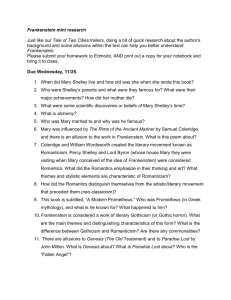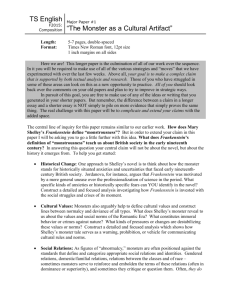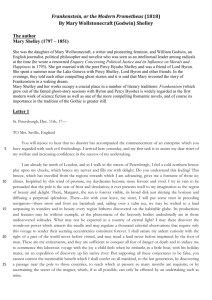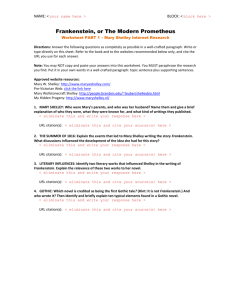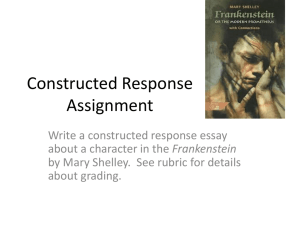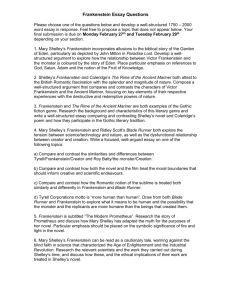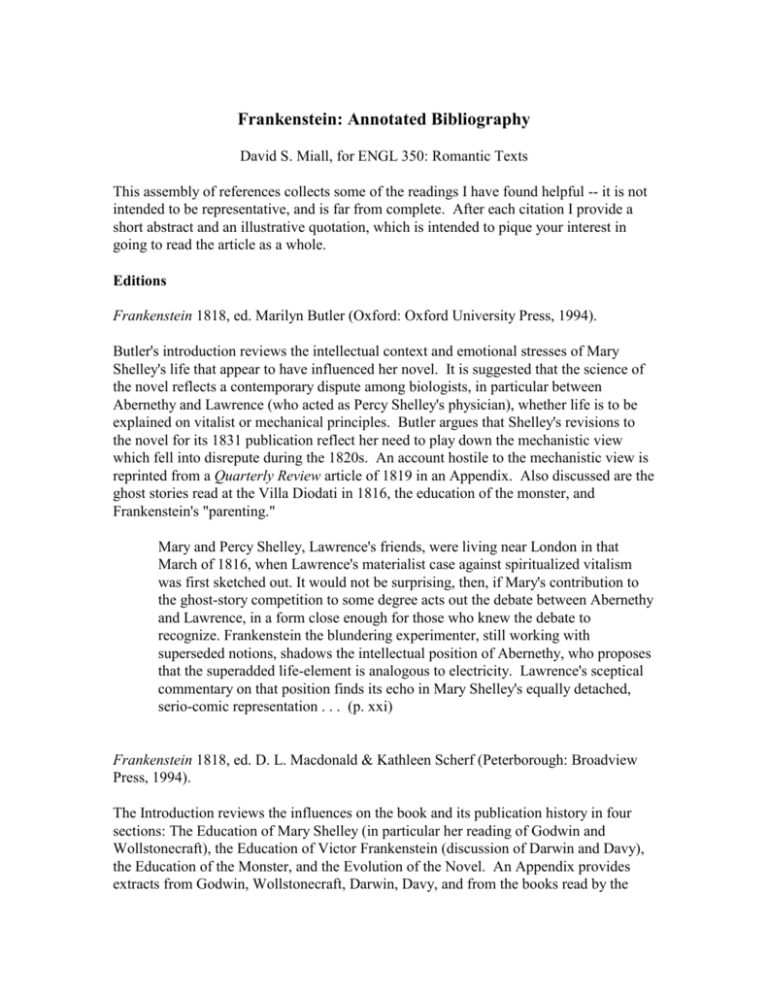
Frankenstein: Annotated Bibliography
David S. Miall, for ENGL 350: Romantic Texts
This assembly of references collects some of the readings I have found helpful -- it is not
intended to be representative, and is far from complete. After each citation I provide a
short abstract and an illustrative quotation, which is intended to pique your interest in
going to read the article as a whole.
Editions
Frankenstein 1818, ed. Marilyn Butler (Oxford: Oxford University Press, 1994).
Butler's introduction reviews the intellectual context and emotional stresses of Mary
Shelley's life that appear to have influenced her novel. It is suggested that the science of
the novel reflects a contemporary dispute among biologists, in particular between
Abernethy and Lawrence (who acted as Percy Shelley's physician), whether life is to be
explained on vitalist or mechanical principles. Butler argues that Shelley's revisions to
the novel for its 1831 publication reflect her need to play down the mechanistic view
which fell into disrepute during the 1820s. An account hostile to the mechanistic view is
reprinted from a Quarterly Review article of 1819 in an Appendix. Also discussed are the
ghost stories read at the Villa Diodati in 1816, the education of the monster, and
Frankenstein's "parenting."
Mary and Percy Shelley, Lawrence's friends, were living near London in that
March of 1816, when Lawrence's materialist case against spiritualized vitalism
was first sketched out. It would not be surprising, then, if Mary's contribution to
the ghost-story competition to some degree acts out the debate between Abernethy
and Lawrence, in a form close enough for those who knew the debate to
recognize. Frankenstein the blundering experimenter, still working with
superseded notions, shadows the intellectual position of Abernethy, who proposes
that the superadded life-element is analogous to electricity. Lawrence's sceptical
commentary on that position finds its echo in Mary Shelley's equally detached,
serio-comic representation . . . (p. xxi)
Frankenstein 1818, ed. D. L. Macdonald & Kathleen Scherf (Peterborough: Broadview
Press, 1994).
The Introduction reviews the influences on the book and its publication history in four
sections: The Education of Mary Shelley (in particular her reading of Godwin and
Wollstonecraft), the Education of Victor Frankenstein (discussion of Darwin and Davy),
the Education of the Monster, and the Evolution of the Novel. An Appendix provides
extracts from Godwin, Wollstonecraft, Darwin, Davy, and from the books read by the
monster: Volney, Goethe, Plutarch, and Milton. The substantive variants in the 1831
edition are listed in another Appendix.
Darwin, who wrote a two-thousand-line poem about the sexual lives of plants, and
who fathered fourteen children, was an enthusiastic advocate of sexual
reproduction. In avoiding it, Victor is not simply descending some abstract
biological hierarchy, but committing a serious offense. The Temple of Nature
explains why. Darwin thinks of the organisms that reproduce by "solitary
reproduction" as male, not as asexual or bisexual. Their offspring resemble them
completely: thus the common interpretation of the monster as a sort of double of
Victor is solidly grounded in Darwinian biology. Sexual reproduction, by contrast,
allows not only for variation but for the blending of masculine and feminine traits,
leading to what William Veeder considers Shelley's psychological ideal,
androgyny. Victor's resort to solitary reproduction shows how far he is from this
ideal. (Introduction, p. 22)
Frankenstein 1831, ed. Johanna M. Smith [Case Studies in Contemporary Criticism]
(Boston: Bedford Books, St. Martin's Press, 1992).
In her introduction, Smith points to the conflicts in the life and writings of her mother,
Mary Wollstonecraft; she also discusses the historical context of Godwin's Political
Justice. In eloping with Percy Shelley, Godwin's disciple, Mary took on the precarious
social situation of her mother, as well as the conflicting demands of intellectual and
domestic life. Reflecting on the potentially revolutionary situation in which Frankenstein
was published (and reissued in 1831), Smith finds echoes of Shelley's sympathies with
both reformist and revolutionary impulses.
If . . . Frankenstein and his culture have created the monster, then there are clear
grounds for two claims: that a society and not its outcasts creates revolutionary
violence, and that the monster's rage is, as Godwin put it, the revolutionary's
"excess of a virtuous feeling." This tension between fear of revolution and
sympathy with the revolutionary reveals Mary's personal ambivalence, but it does
more than that: by making both the conservative and the revolutionary arguments,
Frankenstein dramatizes the tension between the two that characterized England
in the years between 1789 and 1832. (p. 16)
In the Case Book section, after a review of criticism of Frankenstein, five approaches to
the novel are outlined with five essays by different authors. The approaches offered are
reader-response criticism, psychoanalytic (a Lacanian approach is taken in the essay),
feminist, marxist, and cultural criticism.
Frankenstein 1831, ed. M. K. Joseph (Oxford: Oxford University Press, 1980).
Joseph's introduction points to the Romantic associations of the Prometheus myth with
science, especially electricity. Joseph also points to the parallels created by the concentric
layers of the narrative structure, and to the echoes of Paradise Lost in the stories of both
the monster and Frankenstein. The monster is seen as Frankenstein's double.
Prometheus was also an accepted metaphor of the artist, but when Mary Shelley
transfers this to the scientist, the implications are radical. If Frankenstein, as
scientist, is 'the modern Prometheus', then science too is creative; but whereas the
world of art is ideal and speculative, that of science is real and inescapable. It
must then take the consequences: the scientist, himself a creature, has taken on the
role and burden of a creator. If Frankenstein corrupts the monster by his rejection,
which is good Godwinism so far, we are left asking a question which demands
another kind of answer: what has rejected and corrupted Frankenstein? And if
Prometheus, in the romantic tradition, is identified with human revolt, the monster
is what that revolt looks like from the other side -- a pitiful botched-up creature, a
'filthy mass that moved and talked,' which brings nothing but grief and destruction
upon the power that made him? (p. xii)
Articles and Chapters
Brennan, Matthew C., "The Landscape of Grief in Mary Shelley's Frankenstein," Studies
in the Humanities 15:1 (June, 1899), 33-44.
Brennan suggests that Frankenstein is the result of Mary's Shelley's unresolved grief for
the death of her mother. In the novel this is represented by Frankenstein's pursuit of the
sublime in Nature, in contrast to Clerval's and his own earlier preference for the
picturesque prior to the death of his mother. Both Shelley, and Frankenstein in his
scientific pursuit, wished to resurrect the dead. Frankenstein's retreat to the sublime
landscape of the Alps provided a symbolic reunion with the lost mother. In contrast, the
appearance of the monster reminds him of his grief. Mary Shelley overcomes her own
need to regress by writing the novel.
Like Victor Frankenstein and his Monster, Mary Shelley felt the agony and grief
of lacking a nurturing mother. Clearly, Mary Shelley has projected into her
characterization of Frankenstein her own adolescent attraction to the sublime as a
vehicle to escape consciousness of this grief; but, significantly, she also distances
herself from Frankenstein through her narrative structure and in so doing mitigates
her need to regress. Here, with Walton writing letters about Frankenstein, the
narrative frame forms a boundary between, on one hand, the destructive
regression of the self at the center of the story and, on the other hand, the more
rational, socially adjusted self of the frame . . . (p. 41)
Hodges, Devon, "Frankenstein and the Feminine Subversion of the Novel," Tulsa Studies
in Women's Literature 2:2 (Fall, 1983), 155-164.
If the novel in the early 19th century serves to naturalize women's domestic position
within a patriarchal culture, Mary Shelley's novel works to undermine this. By adopting
the male voice in three deviant narrators, Shelley destabilizes its authority. As the
product of a dream, the novel also represents a disruption in the symbolic order. The
monster figures the position of the female writer, neither inside nor outside culture.
Like the monster, woman in a patriarchal society is defined as an absence, an
enigma, mystery, or crime, or she is allowed to be a presence only so that she can
be defined as a lack, a mutilated body that must be repressed to enable men to join
the symbolic order and maintain their mastery. As Baudelaire puts it, "woman is
different, that is to say, abominable." Her difference places her outside culture,
and her abominable presence places her within it. Mary Shelley, because she
writes from this paradoxical position, has been accused of artistic failure: "Mary
Shelley is not inside or outside enough" writes one male critic. But her
representation of the liminal position of women -- and the relation of that position
to sexual categories of a patriarchal culture -- is precisely her achievement. (pp.
162-3)
Moers, Ellen, "Female Gothic," in George Levine & U. C. Knoepflmacher, eds., The
Endurance of Frankenstein, pp. 77-87 (Berkeley: University of California Press, 1974).
Shelley's twist to the Gothic tradition is based on her figurative handling of a myth of
birth, or, more exactly, the trauma of the afterbirth that involves guilt and depression.
This comes, in part, from Shelley's own early experience of childbirth and the suicides of
her half-sister Fanny and Percy's first wife Harriet, experiences which mixed birth and
death during the writing of Frankenstein. The newborn is thus both monster and piteous
victim. Frankenstein's idealism contrasts grotesquely with the material ugliness of his
creation.
Frankenstein, the scientist, runs away and abandons the newborn Monster, who is
and remains nameless. Here, I think, is where Mary Shelley's book is most
interesting, most powerful, and most feminine: in the motif of revulsion against
newborn life and the drama of guilt, dread, and flight surrounding birth and its
consequences. Most of the novel, roughly two of its three volumes, can be said to
deal with the retribution visited upon Monster and creator for deficient infant care.
Frankenstein seems to be distinctly a woman's mythmaking on the subject of birth
precisely because its emphasis is not upon what precedes birth, not upon birth
itself, but upon what follows birth: the trauma of the afterbirth. (p. 81)
Randel, Fred. V., "Frankenstein, Feminism, and the Intertextuality of Mountains," Studies
in Romanticism 23:4 (Winter, 1984), 515-532.
A patriarchal tradition of mountain-top vision, descended from the Bible through Milton,
Wordsworth and Coleridge, is challenged by Percy's Shelley's "Mont Blanc" and by Mary
Shelley in Frankenstein. Mary Shelley's mountain scenes in the novel provide both
regressive and nurturing opportunities, the latter mediated by sound (specifically, the
voice of the monster in contrast to his appearance). At the same time, Frankenstein's
laboratory figures the birthing process as repulsive precisely because the female presence
is suppressed. The concentric narrative structure valorizes the monster, in contrast to
Frankenstein's revulsion and irresponsibility towards his creation.
In the next chapter (ch. x) she introduces a mountaintop experience that holds a
potential for enabling Frankenstein to grow up. The topography again focuses
attention on opposed mountains: Montanvert, with its "somber" "pines," a
mountain incorporating the greenness of fertility, and, on the other hand, "a bare
perpendicular rock" which is the "opposite mountain." The Miltonic alternatives
of generativity and sterility, now severed from a supernatural framework, stand
starkly before us. Frankenstein resolves "to ascend to the summit of Montanvert,"
but he insists on going "without a guide" in order to preserve "the solitary
grandeur of the scene." He "arrived at the top of the ascent" but soon crossed the
glacier to the "opposite mountain" and climbed up its side to a point "exactly
opposite" to Montanvert. His desired isolation is inscribed in the lifelessness and
even the namelessness of this barren crag, where he promptly withdraws into "a
recess of the rock." (p. 526)
Scott, Peter Dale, "Vital Artifice: Mary, Percy, and the Psychopolitical Integrity of
Frankenstein," in George Levine & U. C. Knoepflmacher, eds., The Endurance of
Frankenstein, pp. 172-202 (Berkeley: University of California Press, 1974).
Mary Shelley's response to her experimental and idea-driven life with Percy Shelley helps
shape the figures of Frankenstein and his monster. Frankenstein's education and
enthusiasms are modeled on Percy's, while the monster's vengeance echoes Percy's antipaternal rhetoric against Christianity. Frankenstein shares central themes with Percy's
Revolt of Islam, written at the same time. But Mary also builds on Dante, and on
Volney's critique of patriarchal societies. In the figure of the monster she rehearses her
own ambivalence towards Percy.
In her critique of mere science and mere superstition, and her depiction of more
androgynous alternatives to these unnatural excesses, Mary ultimately adds little
to the ideas of her husband, her two parents, the Lake Poets, and Rousseau. The
great originality of Frankenstein lies in Mary's recognition of her own dreammonster as an artifice of life that is simultaneously parodic, damned, and
quintessentially human. Mary's complexly ambivalent but loving depiction of the
Monster arose out of her complexly ambivalent but loving responses to the artifice
of her own life with Percy, in which fears, resentments, and even self-hatred,
alternated with real hopes of personal and political transcendence. Despite his
imperfections, the Monster emerges as more human than his doublegoing creator:
what has exhausted and dehumanized the father has served to ennoble the
artificially prodigious son. (p. 197)
Youngquist, Paul, "Frankenstein: The Mother, the Daughter, and the Monster,"
Philological Quarterly 70:3 (Summer, 1991), 339-359.
Whereas Wollstonecraft aimed to liberate woman by transcending sexual identity through
the exercise of reason, Mary Shelley in Frankenstein explores the inescapable bodily
imperatives of being a woman. The monster's body determines his fate, which cannot be
averted by his use of reason or language. His appearance calls up an archaic horror of the
defiled which can be related to the impurity of the female realm of generation and
birthing. This is symbolized both by Frankenstein's workshop and by his necrophilic
dream after the monster's animation. The women in the novel, apart from the dead
mother, remain undefiled virgins outside the realm of materiality until destroyed by the
monster, as though in revenge for his defilement. The death of the mother in the novel,
and the absence of mothers in general, is postulated as Shelley's repression of the tragic
potential of motherhood.
For Shelley, body is fate; all idealizings, cultural and personal, liberal and
feminist, mask more profound -- and irrational -- imperatives. If it is ugliness that
fuels the monster's social exclusion, it is beauty that drives his revenge: he
destroys what he cannot possess. Hence the inadequacy of Wollstonecraft's
arguments that reason is natural and beauty mere ornament. They fail to take into
account the bodily imperatives that condition all human lives, male and female. In
Frankenstein, Shelley takes up the greater task of investigating the fate of the
body and its uneasy assimilation to social norms, a task that forces her to swerve
away from the "liberal feminism" of her mother toward a more essentialist
position based in bodily imperatives. (p. 344)



